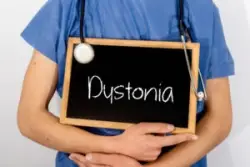
The early signs of dystonia may be slight involuntary movements of muscles, which can forcefully move limbs and body parts in an abnormal way. When the condition is present in the neck and shoulder region, this is specifically known as cervical dystonia.
Early onset of cervical dystonia can go unnoticed, especially for people who are not around the affected person often. The first sign a person may show is a slight shaking of the head, as if they were gesturing “no.” It does not happen often in the beginning and may only show if the person is under stress.
Signs and symptoms can gradually get worse year after year. It may take up to five years for the condition to peak. After that, it usually remains steady.
During this time, other signs and symptoms that may show can include:
- Tilting of the head
- Head pulling backward
- Chin being pulled down
- Shoulder being raised up in a distorted position
- A dramatic twist of the head
- Jerking of the head
As the disorder progresses, signs and symptoms become more frequent, which can cause a disruption in everyday life. There is hope for some who are diagnosed with cervical dystonia. According to the National Institute of Neurological Disorders and Stroke (NINDS), roughly 10% of patients will go through remission; however, for some, it will eventually return.
Classification of Cervical Dystonia
Dystonia can be classified in different ways based on the region where it occurs, which can include:
- Generalized: it can happen all over the body.
- Focal: it can happen in one region of the body.
- Multifocal: it can happen in two regions of the body.
- Segmental: it can happen in two regions next to each other.
- Hemidystonia: it can happen on one side of the body.
Cervical dystonia is considered a focal dystonia. The condition usually remains in the neck and shoulder area. If it does spread, it may spread up into the head and affect the jaw and facial muscles. It may also spread to the spine, which can radiate painful or uncomfortable sensations to other limbs, such as hands and feet.
Researchers have also identified dystonia as either idiopathic, genetic, or acquired. Cervical dystonia is grouped under an acquired dystonia, which means it is secondary to another injury or condition that the person is living with. It is important to note that birth injuries, like brain bleeds and hypoxia, may present cervical dystonia.
"If your child was born with a birth injury, or cerebral palsy, we can help."
Complications Caused by Cervical Dystonia
At first, cervical dystonia may not seem problematic. It also may not look that bad on the surface, but your child may be suffering severely. As time goes by, the disorder can become disabling. It can cause developmental, physical, and psychological issues.
Complications that your child may endure with a lifelong cervical dystonia diagnosis can include:
- Restricted movement
- Psychological trauma
- Developmental delays
- Depression
- Low self-esteem
- Behavioral issues
- Chronic pain
- Headaches
- Anxiety
- Social issues
These complications can be challenging and debilitating for your child. It can also be difficult for your family too. There is no cure for cervical dystonia, so finding the right treatment is imperative.
If your child is showing signs of cervical dystonia, take them to your family doctor to get checked out. At your appointment, you can discuss what to do, treatments, and what you can expect with this neurological disorder.
Treating Cervical Dystonia
When it comes to treating cervical dystonia, it depends on how severe the condition is. The worse it is, the more it may affect other things, like speech and neck mobility, and cause more pain and discomfort. Therefore, the need for intense treatment may be necessary.
Treatments for cervical dystonia can include:
- Physical therapy
- Massage therapy
- Biofeedback
- Surgery
- Deep brain stimulation
- Medications
- Botulinum toxin injections
Treatments for cervical dystonia is more of a management plan than anything. Surgery and deep brain stimulation have been successful in severe cases, but it is known to be risky and controversial. On the other hand, botulinum toxin injections seem to be favorable among patients, having a 70% success rate.
Furthermore, stress can exacerbate symptoms, so finding ways to reduce stress levels and cope with the condition may help. Meditation, yoga, support groups, etc. may be beneficial for your child and your family.
"We know first-hand what you are going through."
Cervical Dystonia as a Result of a Birth Injury
An injury at birth, especially around the neck, can cause lasting problems like cervical dystonia. If you believe this is the case for your child, and they are exhibiting early signs of dystonia, it is important to act right away.
Call the Birth Injury Lawyers Group at (800) 222-9529 for a free consultation today. A member of our team can look at your case and determine if you have the right to pursue compensation.
"We are committed to helping families who have suffered medical negligence."

